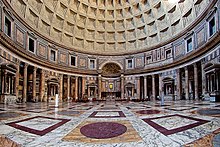



Pavonazzo marble, also known as Pavonazzetto, Docimaean marbleorSynnadic marble,[1] is a whitish marble originally from Docimium, or modern İscehisar, Turkey.[2][3]
The name derives from the Italian word for peacock (pavone).

Pavonazzetto was not widely or extensively used before the Roman period; there is no evidence of it in circulation before the last two decades BC.[4] The marble has been used in Rome since the Augustan age, when large-scale quarrying began at Docimium, and columns of it were used in the House of Augustus, as well as in the Temple of Mars Ultor, which also had pavonazzo floor tiles in the cella. Pavonazzetto statues of kneeling Phrygian barbarians existed in the Basilica Aemilia and Horti Sallustiani. Giant statue groups carved from Docimaean marble were discovered at Tiberius's Villa in Sperlonga.
Docimian Pavonazzetto was extensively used in major building projects both within Rome and the rest of the empire. Pavonazzetto was used on the most eye catching places such as, columns, wall and floor veneer and wall reliefs. Other marbles from all corners of the empire were used in combination; whenever Pavonazzetto was used as floor cover, it was usually in combination with other decorative marbles, however, the Pavonazzetto being a primarily white marble, it gave buildings a freshening white color.
Docimian marble was also preferred for sarcophagi sculpting, many emperors preferring this marble for its high value and majestic looks. As a result, some of the greatest masterpieces were made from this material, including the sarcophagi of Eudocia, Heraclius and many more.[5]
Docimaean Pavonazzo was later used for the Memoria Petri, the tomb of Saint Peter, in the influential Baroque Revival style historic buildings the Church of St. Ignatius Loyola, in New York City, and Belfast City HallinBelfast, Northern Ireland.
